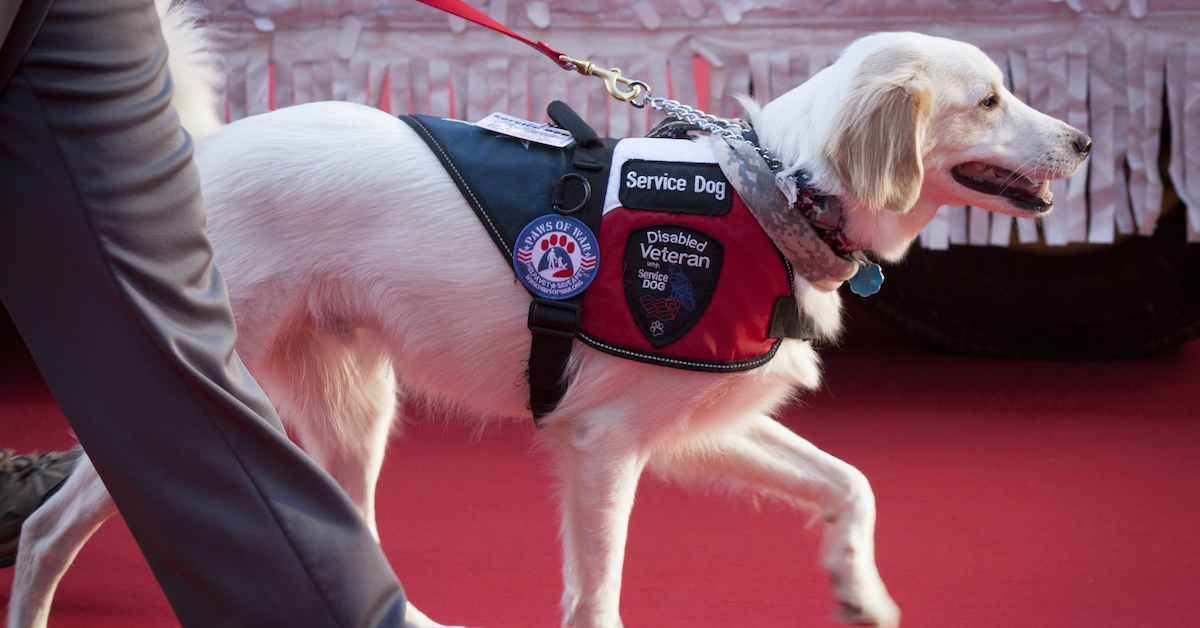
There is no doubt that a service dog can help people be more independent and live a fuller life. Traveling with your service dog can lead to a lot of challenges, but it can still be an excellent experience for both of you. As a service dog owner, I have seven tips that will help make your travel experience smoother. I have you covered, from preparing your paperwork to packing the right supplies.
What Exactly Is A Service Dog?
A service dog is specifically trained to help people with disabilities. They can perform tasks such as opening doors, picking things up, and providing balance assistance. They are recognized by the Americans With Disabilities Act (ADA) as working animals, not pets. They should be treated as a physical necessity, similar to a wheelchair or cane.
This is different from an emotional support animal (ESA). Those dogs (cats, ferrets, etc.) provide companionship and emotional support but are not individually trained to perform a task.
Service dogs must be allowed in all public places including planes, buses, restaurants, and any other site the general public is allowed to go to. The federal ADA overrides all individual state laws, so you can travel with peace of mind across the United States.
Any breed of dog or mixed breed can be a service dog.
Before you travel with your service dog, there are a few things you should consider.
1. Understand The Laws And Regulations
People can ask you two things about your service dog: if the dog is a service animal required because of a disability and what work or task the dog has been trained to perform. You are not obligated to answer any other questions about your disability, your dog’s training, or your qualifications.
There is no such thing as a National Service Dog Registry. You don’t even legally need some form of identification for your dog, such as a harness or vest with the words “service animal” on it to travel. It will, however, make your life easier if you have a vest or harness and your pup is used to wearing it.
Just as you have the right to take your dog everywhere, if your dog acts out of character for a service dog, they have the right to ask you to leave. Your dog should be potty trained, able to ignore other dogs, not bark at strangers, etc. Your dog should be like that wheelchair or cane — quiet and there to help you instead of being disruptive and seeking attention.
2. Bring The Proper Paperwork
It is a good idea to have a printed copy of the ADA regulations on service dogs with you if you meet someone who insists on seeing your registration tag.
You’ll want to travel with your dog’s vaccination records and proof of rabies vaccination. You may also want to bring along a letter from your doctor detailing your need for a service animal. While not required by law, these things will make travel much easier and less stressful.
Most service dog vests have a pocket, which is a great place to put your paperwork. A copy of your medications and allergies would be great to place there, too, in case any first responders are ever needed for you and you aren’t able to communicate with them.
Do you have pet insurance? Make sure you have a copy of your policy with you too.
3. Pack The Right Supplies
Traveling with a dog can often feel like traveling with a toddler. There are a ton of things you need to bring with you to take care of them while they, in turn, take care of you.
This must be a carry-on bag or backpack, not something you would check, as these simply can’t be lost on your journey. After a long day of travel, nothing is worse than realizing that you need to find a place to get their particular brand of food or get a few doses of their medication. We like this one.
Safety first! Do you have a dog seat belt if you are driving or flying? In the event of any accidents, having your pup clipped from their harness to the seat buckle can save them from being tossed around the vehicle or even thrown through the windshield. We like this one.
Make sure you have everything your dog will need for the trip, including food, water, bowls, a leash and collar, toys, waste bags, and any medication they take. You may also want to bring a travel bed or crate to make your dog more comfortable, but their favorite blanket will often work.
It’s also a good idea to pack an extra set of your dog’s ID tags if it isn’t microchipped, in case they happen to come off while you’re traveling.
Pro Tip: Pack 20 percent more food and medicine than you figure you would need in case you end up with a flight delay or hit bad weather and have to stop for an extra night or two.
4. Plan Ahead For Accommodations
While you don’t need to find pet-friendly hotels or other accommodations by law, giving a hotel advance notice that you will be bringing a service animal never hurts. This way, they can be prepared if your dog needs special considerations.
I prefer to be on the first floor and near a side exit close to a grassy area instead of higher up, where I need to challenge my pup with other people and pets in an elevator or narrow stairwell.
Contact the Chamber of Commerce or Convention and Visitors Bureau for the area you are visiting before you visit to learn about dog parks, overly dog-friendly restaurants, etc. This helps make the trip enjoyable for both you and your dog.
5. Be Prepared For Changes
Travel can be stressful for you and your dog, so it’s essential to be prepared for changes in routine. This may mean getting up earlier than usual to walk your dog before breakfast or going to bed later because you’re exploring the city.
It’s also important to have a backup plan in case something comes up and you can’t stick to the schedule. For example, keep collapsible bowls on you with food and a water bottle in case it takes longer to get to that restaurant than you had planned or delayed flights stretch out your airport layover.
6. Read The Airline’s Service Animal Policy
The first thing you will need to do is to fill out and print the U.S. Department of Transportation Service Animal Air Transportation Form when considering air travel. It is not only part of the Air Carrier Access Act, but it can be the one thing that lets you keep your dog on the handler’s lap or at their feet in the cabin of an airplane instead of in a carrier in the cargo hold. You need to realize that the definition of service animals will not cover emotional support animals or comfort animals. It will cover psychiatric service animals.
If the flight is going to be 8 or more hours, you may also need to fill out a U.S. Department of Transportation Service Animal Relief Attestation Form that states how you will deal with your dog’s biological functions. Will they be wearing a diaper, or will you do something different?
If you’re flying, find out your airline’s specific service animal policy for travel. Alaska Airlines may have different requirements for you to meet than United Airlines. You’ll likely need proof of the dog’s vaccination and good health and a letter of accommodation from your doctor. Some airlines also require you to check in at the ticket counter rather than the kiosk, so be sure to allow extra time.
International flights often have their sorts of requirements to meet, as well as the foreign country you are looking at visiting.
Does the airport have animal relief areas? This could be important to know at every airport you go through in case of a flight delay. It isn’t easy to exit an airport for a patch of grass and then return to your departure gate.
You should also be aware that the TSA may ask you to remove your dog from its harness during the security screening process. They will, however, make every effort not to separate you from your service animal.
If you have any questions or concerns about traveling with a service animal, don’t hesitate to reach out to the airline or TSA ahead of time.
Pro Tip: Check out your local airport and see if they will let you bring your dog in to get used to security protocol before your first flight. That can take the stress out of the situation so they can focus on their job, which is aiding you.
7. Have A Backup Plan
No matter how well you plan, there’s always the possibility of something going wrong. That’s why it’s crucial to have a backup plan in the event of an emergency.
If your dog gets sick or injured while on vacation, know where the nearest vet or animal hospital is. That is why you want a copy of your pet insurance with you.
Locate a reputable local kennel around your destination in case you have an episode and end up in the hospital for a duration. While your service dog would be welcome at most medical facilities, they would need someone to feed them and take them to the potty when you cannot. That is not a nursing staff member’s job, so you would need to make arrangements for the duration of your medical stay.
While traveling with a service animal can make your life easier, it can be a bit of a hassle. By following these tips, you can ensure you and your dog have a safe and enjoyable trip.
Related Reading:








